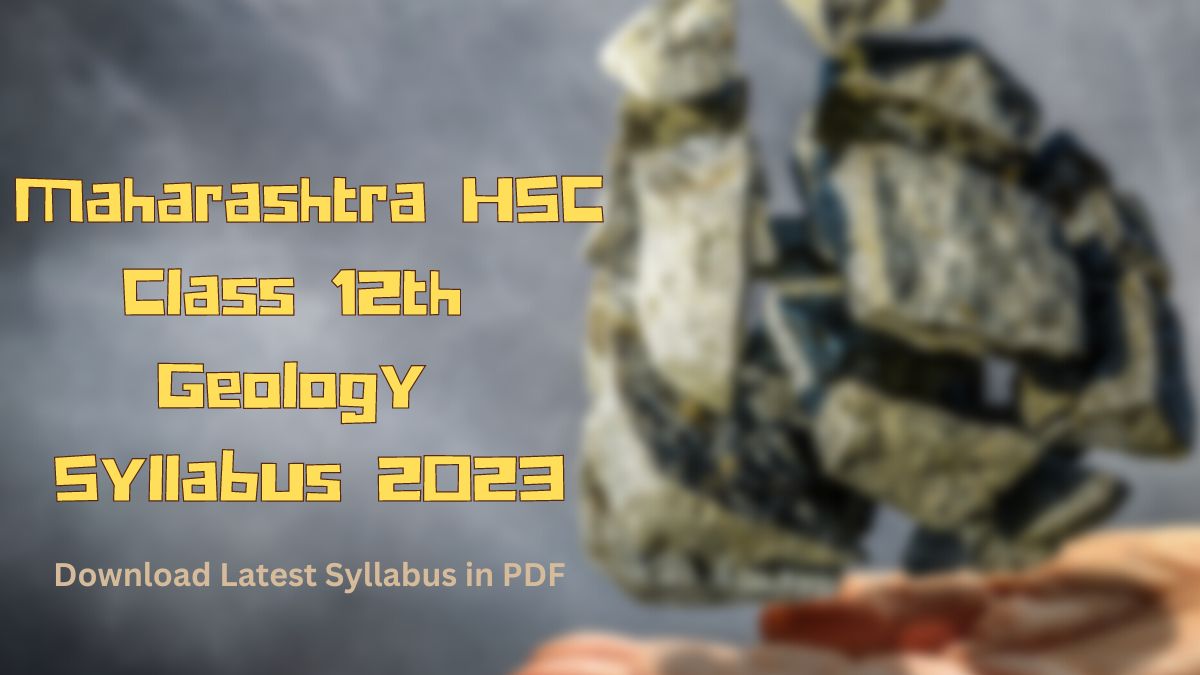Jagran Josh
Maharashtra State Board HSC Geology Syllabus 2023: Download the latest Syllabus for Class 12th Geology under Maharashtra State Board of Secondary & Higher Secondary Education for HSC board exams 2023.
Maharashtra State Board HSC Geology Syllabus 2023: In this article we will view the syllabus of Geology released by Maharashtra State Board of Secondary & Higher Secondary Education for class 12th HSC Students. At the end of the syllabus content, we will also attach the link to download the latest Geology syllabus in PDF format.
Geology is the branch of Science that deals with the origin, interior and composition of the earth and primarily the rocks, their constituents as minerals, their structures and the way of their distribution has taken place on the continents and also on the ocean floor. It is not only the study of surface processes and surface geology but also various processes in the interior of the earth.
View the Maharashtra State Board HSC Geology Syllabus 2023 for class 12th below:
Paper – I
- Dynamic Geology
1.1 Earthquakes – Definition, Causes, Seismic waves, Magnitude and Intensity
1.2 Volcanoes – Types, Products, Associated features
1.3 Mountains – Types
1.4 Natural Hazards and Disasters – Classification
i) Tectonic – Earthquakes – Effects, Precautions, Seismic Zones of India
ii) Topographic – Landslides – Causes, Forms and Effects. Disaster Management.
- Structural Geology
2.1 Outcrop, Dip and Strike of bed
2.2 Fold
Definition, Elements of fold, Anticline, Syncline, Symmetrical and Asymmetrical
2.3 Fault
Definition, Elements of fault, Normal, Reverse, Horst and Graben
2.4 Joint
Definition, Geometrical and Genetical classification
2.5 Unconformity
Definition, formation of Unconformity Disconformity, Nonconformity and Angular unconformity.
- Palaeontology and Stratigraphy
3.1 Fossils
Conditions and Modes of preservation and Uses.
3.2 Stratigraphy of Peninsulor India
Principles, Correlation and its methods. Standard Geological Time Scale.
3.3 Stratigraphy of Peninsular India.
Physiographic Divisions of Peninsular India, Brief outline of stratigraphy of Peninsular India.
Paper – II
- Materials of the Crust
4.1 Mineralogy – Definition : Rock forming mineral groups
- Feldspar Group – Microcline, Plagioclase.
- Silica group – Quartz, Amethyst, Chalcedony, Flint, Jasper, Opal.
- Amphibole group – Hornblende, Asbestos
- Pyroxene group – Augite
- Mica group – Biotite, Phlogopite.
- Olivine group – Olivine.
- Other minerals – Kyanite, Corundum, Gypsum, Calcite, Garnet
4.2 Petrology
Definition of rock, rock cycle
A) Igneous –
Definition, classification based on silica percentage, mode of occurrence, colour, Texture-Crystallinity, Granularity, Mutual relationship, Granitic, Porphyritic.
Structure – Vesicular and Amygdaloidal.
Forms – Extrusive and Intrusive
B) Secondary / Sedimentary
Definition, classification – based on products of weathering.
Texture – Size, Shape, Form. Structure – Stratification, Lamination, Graded
bedding, Cross bedding, Ripple marks.
C) Metamorphic Definition , Agents, Types and Zones
Structure – Slaty, Granulose, Schistose and Gneissose.
- Economic Geology
5.1 Definition of Ore, Ore mineral, Industrial mineral, Gangue, Tenor of ore
5.2 Ores
- Iron Ore – Hematite, Magnetite
- Manganese Ore – Pyrolusite, Psilomelane
- Copper Ore – Chalcopyrite
- Lead Ore – Galena
- Aluminium Ore – Bauxite
5.3 Mineral/Rock Based Industries –
Fuel – Coal, Petroleum
Cement – Limestone, Gypsum
Fertilizers – Gypsum
Refractories – Bauxite, Kyanite
Abrasives – Diamond, Corundum
Electric and Electronics – Mica and Quartz
Medicines – Mica, Iron ore, Copper ore
- Applied Geology
6.1 Ground Water –
Source and Zones of groundwater, Water table and Aquifer and their types. Conservation and Management of groundwater.
6.2 Remote Sensing –
Definition, Elements of photo recognition Tone, Texture, Size, Shape, Association, Recognition of terrain features – Relief (Plain, Hills and Ranges), Drainage (Streams, River), Exposures- (Vegetation, Soil and Rocks, Lineaments)
Manmade features – (Road, Town/ village, Agriculture field)
6.3 GIS –
Components of Geographical Information System. Importance and significance of G.I.S.
Geology plays an important role in industrial and economic development of the country. Therefore, students should not only be able to score well but also implement the knowledge to appreciate nature and do their part in saving the environment.
All the best!
#Maharashtra #State #Board #HSC #Geology #Syllabus #Download #Latest #Syllabus #Class #12th
